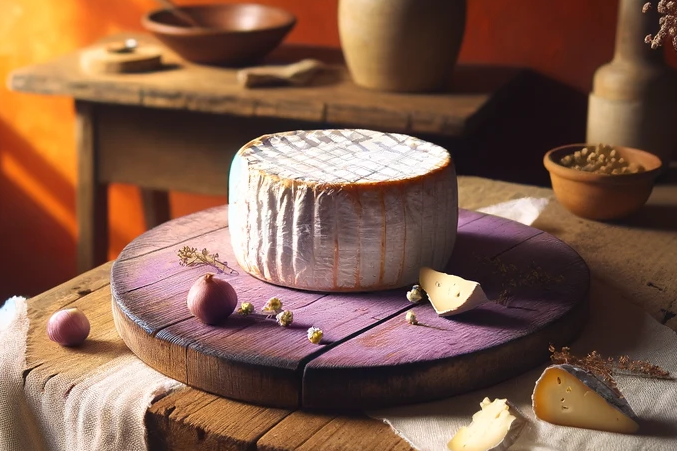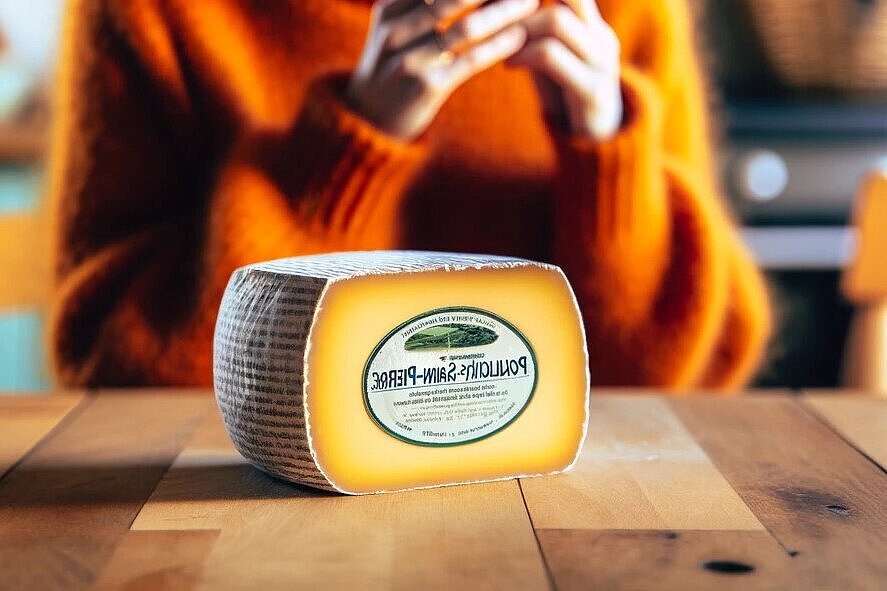Crottin de Chavignol

Crottin de Chavignol is a semi-soft goat's milk cheese from the rural area of Pays-Fort-Sancerrois in the Loire Valley in the Cher department in the Centre region of France. Crottin de Chavignol is considered the most famous crottin cheese from the Loire Valley and takes its name from the small commune of Chavignol on the Loire near the town of Sancerre, which has barely 200 inhabitants. Crottin de Chavignol has been recognized as an AOC cheese (Appelation d'Origine Contrôlée) since 1976 and has been awarded the AOP seal (Appellation d'origine protégé; protected designation of origin, PDO) throughout the EU since 1996.
In this article, you will find out more about the history, production, appearance and taste of this special goat's cheese and how you can enjoy it. We also discuss the advantages and disadvantages of Crottin de Chavignol for dogs.
The history of Crottin de Chavignol
Goat farming has been common in the region since the 16th century. It was mainly the winegrowers' wives who looked after the animals, made cheese from their milk and sold it to earn extra money. However, the Crottin de Chavignol was first mentioned in writing in 1829. The infestation of vines by phylloxera at the beginning of the 19th century and the outbreak of foot-and-mouth disease favored goat farming, so that cheese production could be increased. The 19th century also saw the first affineurs, who collected the cheeses from the various cheese dairies and then sold them. Thanks to the construction of the Paris - Nevers railroad line, the cheeses could also be quickly transported to the capital and sold there.
The origin of the name "Crottin" is disputed. "Crot" refers to a small round oil lamp made of fired clay, the shape of which is reminiscent of the molds in which the cheese curds for the Crottin de Chavignol are filled. However, "crottin" also refers to horse apples and could refer to a long-ripened Crottin de Chavignol, which resembles horse apples with its shrivelled appearance and dark brown rind as it matures. As various goat's cheeses are produced in the region as "Crottin", the Crottin de Chavignol was named after the small village in whose surroundings it is produced to distinguish it.
The production of Crottin de Chavignol
Only raw goat's milk is used to make Crottin de Chavignol. This is curdled with only a very small amount of rennet. The curd is then filled into special cylindrical molds in which it takes shape for 12 to 24 hours. The Crottin de Chavignol is then removed from the molds, salted and left to mature for at least 10 days, but can also be stored for up to 3 months or longer.
The appearance and taste of Crottin de Chavignol
Ready-matured Crottin de Chavignol has a cylindrical shape with a height of around 3 to 4 cm and a diameter of around 4 to 5 cm. It weighs between 60 and 80 grams. Its rind is white, yellow, gray or brown, depending on the degree of ripeness, and may be covered with mold. Its paste is creamy, firm or crumbly depending on the degree of ripeness and has an ivory to straw-yellow color. It contains at least 45% fat in dry matter.
The taste of Crottin de Chavignol also varies depending on the degree of ripeness. Young cheeses have a mild, fresh and slightly acidic taste reminiscent of citrus fruits. Medium-aged cheeses have a more intense, nutty and spicy flavor, reminiscent of hazelnuts. Old cheeses have a strong, salty and peppery flavor reminiscent of ham.
How to enjoy Crottin de Chavignol
Crottin de Chavignol can be enjoyed in different ways, depending on your personal taste and degree of ripeness. Young cheeses are good as a snack or as part of a cheese platter. They can also be combined with salad, fruit or honey. Medium-aged cheeses can be baked or grilled and go well with bread or potatoes. They can also be accompanied with Sancerre wine, which comes from the same region. Old cheeses can be grated or melted and add a special flavor to dishes such as quiche, pizza or pasta.
The advantages and disadvantages of Crottin de Chavignol for dogs
Crottin de Chavignol is a delicious cheese for humans, but is it also good for dogs? The answer is: it depends. Cheese can have some advantages for dogs, but also some disadvantages.
The benefits of cheese for dogs include:
- It is a good source of protein, calcium, phosphorus and vitamin A, which are important for muscle, bone and skin health.
- It can be used as a reward or treat to aid training or education.
- It can help clean teeth and prevent tartar by stimulating salivation.
- It can help increase the appetite of fussy or sick dogs.
The disadvantages of cheese for dogs include:
- It is high in fat and calories, which can lead to obesity or pancreatitis if fed in large quantities or frequently.
- It contains lactose, which some dogs cannot digest well and can lead to diarrhea or flatulence.
- It can trigger allergies or intolerances, which can manifest themselves in skin rashes, itching or stomach problems.
- It may contain salt, which can be harmful to dogs if consumed in large quantities.
Crottin de Chavignol is a semi-soft goat's cheese with a relatively high fat content (45% fat in dry matter) and a moderate salt content (1% salt in dry matter). It also contains lactose (4% lactose in dry matter), which some dogs cannot tolerate. Crottin de Chavignol is therefore not an ideal cheese for dogs.
If you still want to give your dog Crottin de Chavignol, you should take a few precautions:
- Give him only small amounts (less than 10 grams per day) and not too often (no more than once a week).
- Monitor his health and behavior after eating.
If you notice any signs of hypersensitivity or poisoning in your dog, you should see your vet immediately. We are not a substitute for a vet, but we try to be as accurate as possible. Every dog reacts differently and we recommend you get a second opinion or consult your vet if in doubt.
Stay healthy and take good care of your four-legged friend!😊
Similar to Crottin de Chavignol
You may be wondering whether you can give your dog Valençay as a treat or as part of his diet. The answer is not as simple as you might think. There are some pros and cons that you should consider...
Chèvre can have several benefits for dogs when fed in moderation. On the one hand, it can serve as a tasty reward that makes training easier. Secondly, it can aid digestion as it contains probiotic...
Pouligny-Saint-Pierre is a French goat's cheese that takes its name from the commune of the same name in the heart of France. This cheese is known for its pyramid shape and its gray-white rind with...
Rocamadour is a small, round goat's cheese with a delicate, white rind and a soft, creamy texture on the inside. It belongs to the Cabécou family of cheeses and is certified by the AOC (Appellation...



